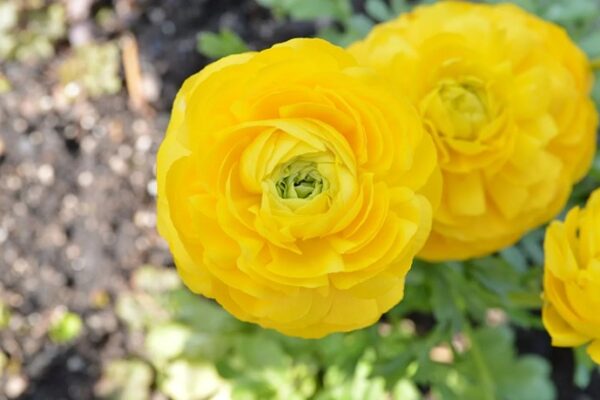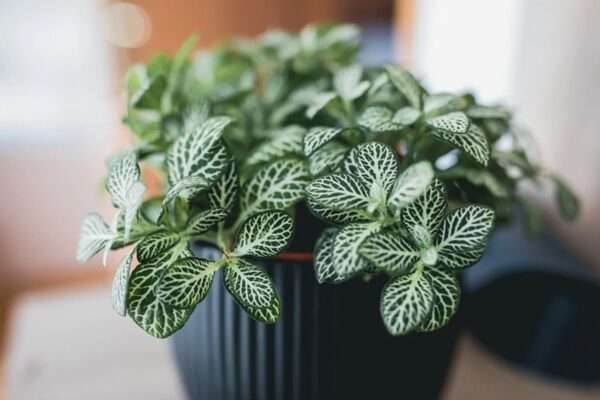Indoor Palm Trees: A Guide to Growing Well
Indoor palm trees provide an easy way to add a tropical and lush feel to your indoor space. Slow growing low maintenance and high appeal in home. These plants come in a variety of sizes, colors, and shapes.
One of the most popular species of indoor palm is the parlor palm (Chamaedorea elegans), which can thrive even in low-light conditions. With many different types of indoor palms that can flourish, you have plenty of options to choose from to complete the look of your space. It’s important to select a palm variety that is safe for your household, as some species like the sago palm and cardboard palm can be toxic to pets.
To care for your indoor palm tree, follow these simple guidelines that are suitable for most common indoor species.
- Botanical Name: Chamaedorea elegans
- Common Name: Parlor palm
- Plant Type: Palm tree
- Mature Size: 5-8 feet high
- Sun Exposure: Low to medium, indirect sun
- Soil Type: Well-drained cactus and palm soil, all-purpose potting mix
- Soil pH: 1–7.5
- Toxicity: Non-toxic3

Plant Care
Growing indoor palm trees is a relatively straightforward process that doesn’t require a significant amount of time and effort. Adequate fertilization, water, and sunlight exposure are the primary factors that influence their growth.
It’s essential to keep the soil of your indoor palm consistently moist, particularly during the spring and summer months. To achieve this, check the soil frequently, and water the plant as needed. You can also fertilize your palm tree once a month during this period using a houseplant fertilizer. However, during the winter months, it’s best to avoid fertilizing as the plant’s growth slows down.
Since indoor palm trees are native to tropical regions, they require a high level of humidity to grow correctly. Unfortunately, most indoor spaces don’t offer enough moisture, particularly when the air conditioning is on. Therefore, it’s advisable to use a plant mister or humidifier to maintain the required humidity level for your palm to thrive. This helps keep things healthy and promote healthy growth.
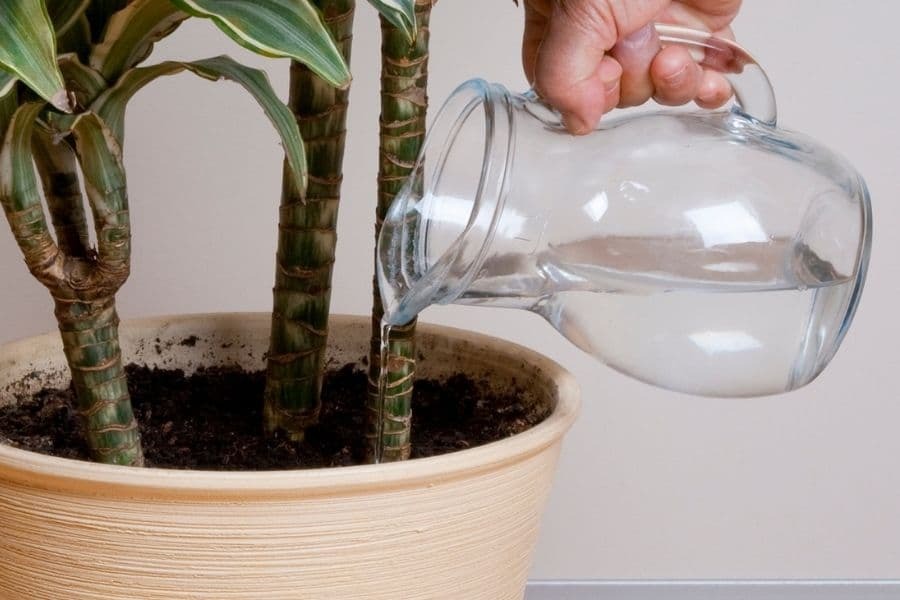
Optimal Growing Conditions for Indoor Palms Trees
To ensure optimal growth of your indoor palm tree, it’s crucial to maintain the appropriate temperature and lighting conditions. Ensure that the area where you keep your palm tree does not experience nighttime temperatures below 50 degrees.
While some varieties of indoor palms, like the parlor palm, kentia palm, and lady palm, can thrive in low-light conditions, most species do better in bright, indirect light. For palms that require direct sun, the best placement is in windows that face south or west. However, it’s best to avoid direct sunlight for most indoor palms, especially during the summer months. You can choose to move your palm tree to different locations for proper sun exposure in different seasons, keeping in mind its mature size.
Since palms thrive in humid environments, bathrooms make excellent locations for them. They do well in high humidity environments, which can help to promote healthy growth.
If you notice that your palm tree’s leaves are turning yellow or brown and the soil is still moist to the touch, it’s likely that the plant is overwatered. On the other hand, curled fronds, brown tips, and thin leaves all indicate that it’s time to water your tree. Regularly checking your palm’s leaves for signs of dryness or overwatering is crucial for its health and growth.
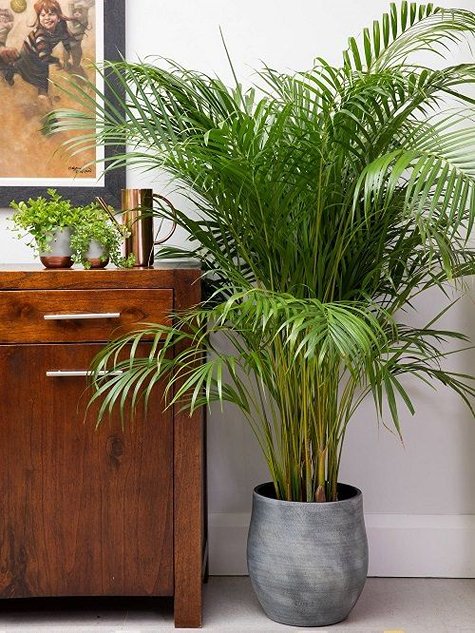
Types of Indoor Palm Trees
Palm trees come in a variety of shapes and sizes, with unique foliage that ranges from fan-shaped fronds to colorful spikes. Although these trees belong to different plant families, they all require similar care to ensure healthy growth.
Indoor palm trees include dwarf varieties like miniature date palms (Phoenix roebelenii) and European fan palms (Chamaerops humilis). Some varieties grow quite tall at maturity in nature—like the Christmas palm (Adonidia merrillii)—or have fanned leaves like banana palms (Musa acuminata) and fountain palms (Livistona chinensis), which need room for large fronds to spread out.
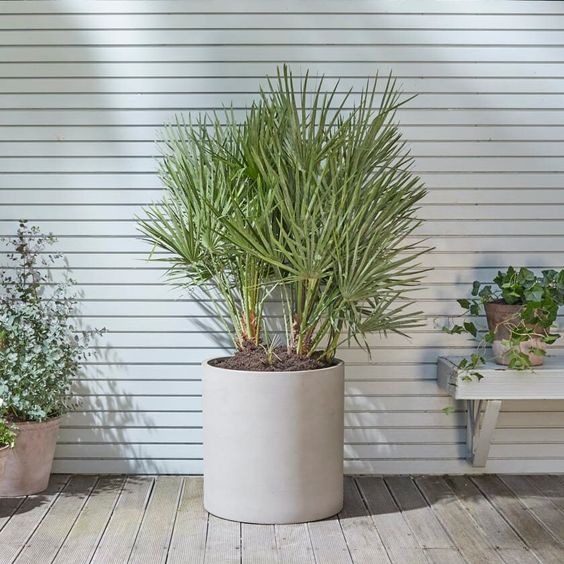
Other varieties of indoor palms trees such as the lady palm (Rhapis excelsa) and parlor palms can thrive even in low-light conditions. Some palm variants, like the ponytail palm (Beaucarnea recurvata) and butterfly palm (Dypsis lutescens), are well-suited for indoor environments due to their smaller size. These species can be an excellent option if you’re looking for a palm tree that fits well in limited spaces, such as apartments or small rooms. They can add a tropical feel to your interior decor without taking up too much space or requiring too much maintenance.
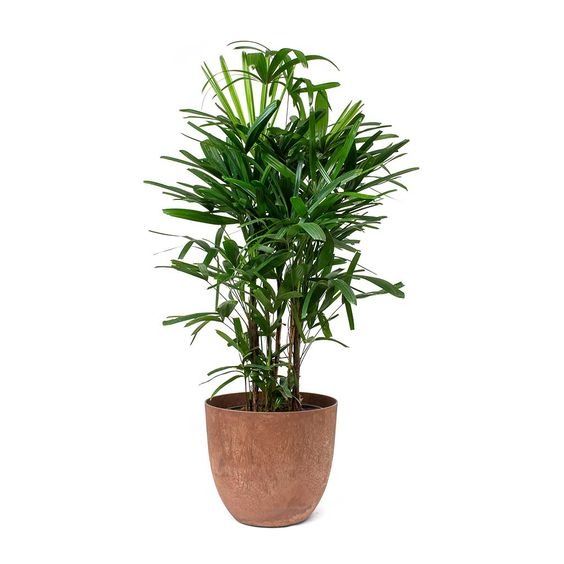
Some indoor palm tree species have unique and colorful features that make them stand out. For example, the lipstick palm (Cyrtostachys renda) has red stems and feathery fronds that thrive in direct sunlight. Another species, the flame thrower palm (Chambeyronia macrocarpa), has new leaflets that emerge bright red before maturing to green. These striking features make these palm trees an excellent choice for those who want to add a pop of color to their indoor space. However, keep in mind that these species may require more care and attention than other indoor palm varieties.
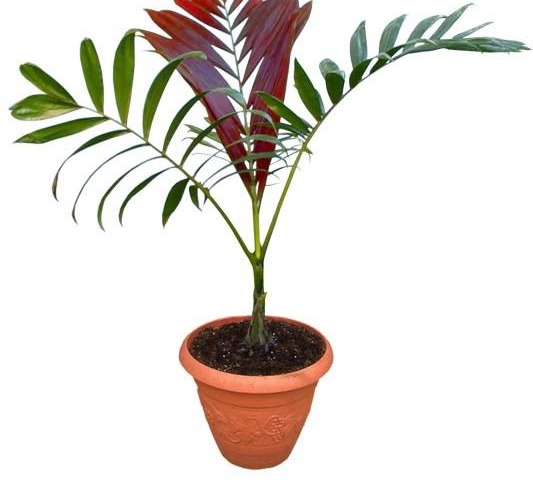
Propagate Indoor Palm Trees
If you want to grow a new indoor palm, it is recommended that you avoid propagating them from seed, as this method is best left to professional growers. However, there are several ways to propagate palm trees depending on the type of palm species. For example, some varieties can be propagated by removing “pups” or offsets from the mother plant, which are small plants that grow at the base of the main plant. Clumping palm varieties can also be divided, and “suckers” from some palm species can be separated to create new plants. These methods of propagation are less complex and more suitable for novice gardeners. However, it’s essential to follow proper techniques and handle the plant with care to avoid damaging the parent or newly propagated plant.
Propagation of Indoor Palm Trees through Division
If you want to propagate clumping varieties of palm, such as parlor palms, through division, follow these steps:
- Step 1: Collect several pots to hold the stems of the mother plant. Fill each pot with soilless mix, and moisten it with water.
- Step 2: Carefully remove the mother plant from its container, and gently loosen the soil around the roots.
- Step 3: Look for established stem clumps that have their own root systems. Using a sharp and clean gardening blade, separate the roots, ensuring that each main root system remains intact.
- Step 4: Plant each stem clump into its own pot. Keep the soil moist, and place your new plants in a warm and shady location to help them recover. Care for your new plants as you would any other indoor palm tree.
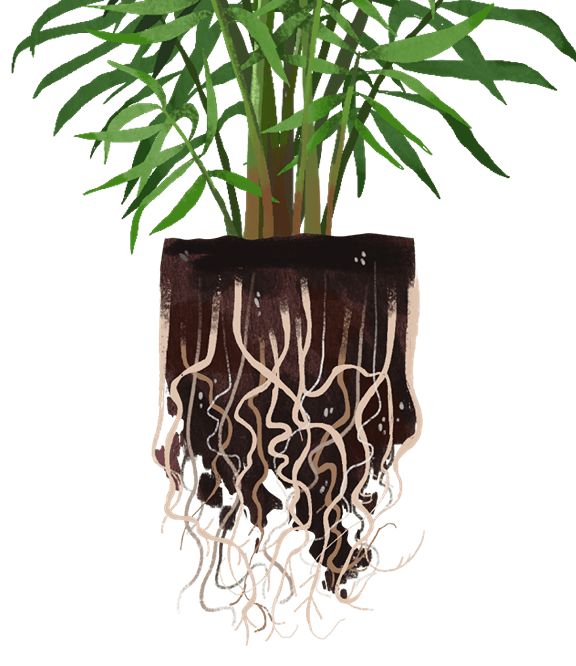
How to Propagate Indoor Palm Trees via Pups
Propagation of some palm variants, such as miniature date palms, sago palms, and ponytail palms, can be done by growing pups from the mother plant. It’s best to let the pup grow for a few years before propagating it so that it can develop its own root system. Here’s how to propagate a pup:
- Step 1: Carefully remove some soil around the base of the pup to check if it has several roots.
- Step 2: Prepare a new pot with a soilless potting mix and moisten it with water.
- Step 3: Gently remove soil around the pup, leaving some attached to protect the delicate roots. Using a clean, sharp blade, cut the pup away, and making sure to leave several intact roots.
- Step 4: Plant the pup in its pot, ensuring that the lowest leaves are above the soil’s surface. Place a clear plastic bag over the plant to create a humid environment and use chopsticks or pencils to keep the bag from touching the leaves.
- Step 5: Put the pot in a location with bright, indirect light, and keep the soil moist. When new leaves start growing, remove the plastic bag and continue caring for your palm as usual.
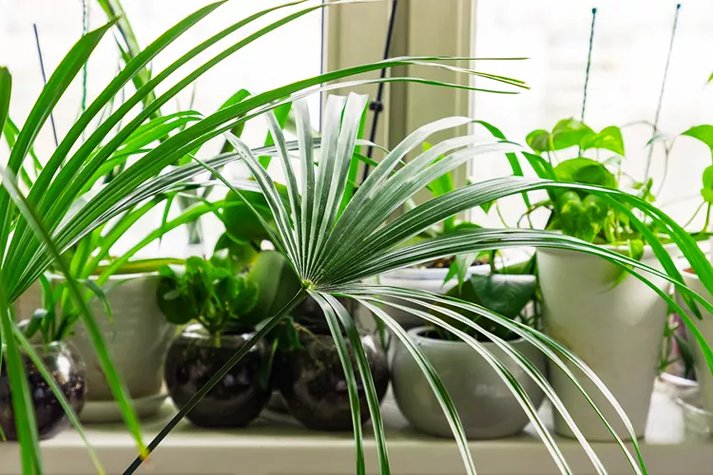
A Guide to Propagating Indoor Palm Trees Using Suckers
If you want to propagate indoor palms, that grow suckers, here’s how you can do it:
- Step 1: Get your containers ready by filling them with potting mix and watering them until the soil is moist.
- Step 2: Loosen the soil around the base of the sucker you want to remove. Gently pull the sucker up and locate its roots.
- Step 3: Using a sharp, clean blade carefully cut the sucker away, making sure to keep its roots intact. Be careful not to damage the mother plant.
- Step 4: Plant the sucker in the prepared container. Place the new plant in a warm, shady spot to recover and keep the soil consistently moist.
Indoor Palm Trees: Troubleshooting Common Issues
Taking care of indoor palms is relatively easy, but problems such as pests, yellow or brown leaves, or dry foliage can arise. Here are some tips on how to treat these issues:
Brown or Yellow Leaves
You can easily tell whether your palm needs water or not based on the appearance of its leaves. If the tips of the leaves are brown and dry, this is a sign that the plant needs more water. On the other hand, if the leaves are turning yellow and the stem is dark, it may be due to overwatering. It is important to adjust the watering needs accordingly to ensure that the plant is thriving in its optimal conditions. If you notice that the base of the trunk is starting to rot, it is essential to repot the plant immediately with fresh, well-draining soil to prevent further damage.
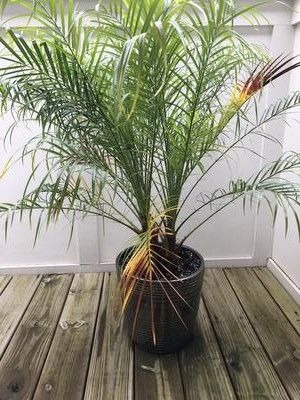
Pests
Indoor palms are often attacked by pests like spider mites. Signs of infestation include spotted, curling, or dropping leaves, as well as webbing on stems and the undersides of leaves. If you notice any of these symptoms, it’s important to act quickly to prevent the pests from spreading.
To treat spider mites, start by pruning off any infested branches, bagging them, and disposing of them in an outdoor trash can. This will help prevent the pests from spreading to other parts of the plant. Next, mix 1.5 tablespoons of neem oil with one quart of warm water and spray the palm every three to five days. The neem oil will help prevent pests from returning and keep your palm healthy.
It’s important to be vigilant for signs of pest infestation and to treat them as soon as possible to avoid serious damage to your plant.

Potting and Repotting Indoor Palm Trees
Even though indoor palms may seem crowded, they generally thrive in the same container for several years. It is best to repot your palm during the spring or early summer when it is actively growing.
For a growing medium, use potting soil that is well-draining. Many variants, including Parlor palms, can grow in either all-purpose soil or a soilless blend, such as store-bought cactus or succulent mix. You can also create your own soilless mix by mixing equal parts of peat moss and either vermiculite or perlite.
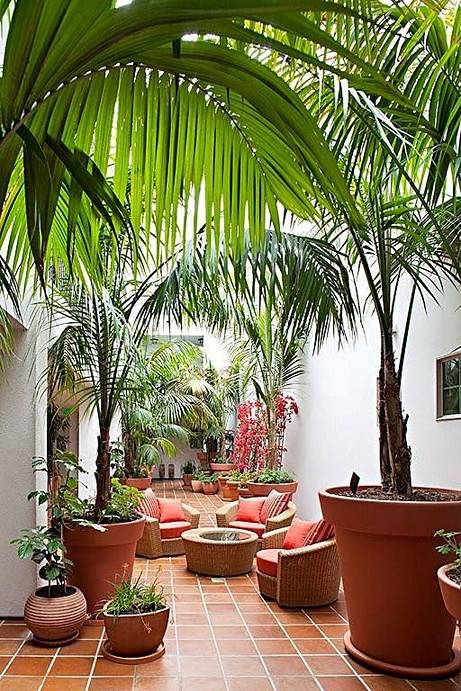
FAQs
Lifespan of Palm Trees: How Long Do They Live?
The lifespan of a palm tree can vary depending on various factors, such as the species of palm and the climate it is grown in. For a instance, tropical outdoor palm can have a lifespan of up to 100 years, while other species may have a shorter lifespan. Factors such as proper care, disease prevention, and environmental conditions can also influence the lifespan of a palm tree. Proper care, such as regular watering and fertilization, can promote healthy growth and increase the lifespan of the tree. However, certain diseases, pests, and harsh environmental conditions, such as extreme temperatures or storms, can also impact the lifespan of a palm tree.
Growth Rate of Palm Trees: How Quickly Do They Grow?
The growth rate of palms varies among species, but on average, they can grow up to 10 inches per year in their natural habitats. However, indoor palm trees typically have a slower growth rate due to the limited light, space, and nutrients they receive. Therefore, you should expect your indoor palm to grow at a slower rate than its outdoor counterparts. The growth rate also depends on the care and maintenance you provide to your palm, such as proper watering, fertilizing, and pruning.
Can Palm Trees Thrive in All Environments?
Certain palm tree species have adapted to grow in colder climates and can survive temperatures as low as zero degrees Fahrenheit (-18 degrees Celsius). These hardy palm species include the Windmill Palm, Needle Palm, and Dwarf Palmetto. Because of their cold tolerance, these palms can be grown in many regions throughout the United States that experience freezing temperatures. However, it’s important to note that palms have specific requirements for soil, water, and sunlight, so proper care and maintenance are still necessary for their survival, even in colder climates.
How to Care for Palm Trees: Tips and Tricks
Palms have become a popular choice for indoor plants due to their easy-to-care-for nature and low maintenance needs. They are generally considered to be low maintenance plants as they do not require frequent watering or pruning, and can thrive in a variety of lighting conditions. They are also adaptable to different temperatures, although they prefer warm and humid environments. Due to these factors, palm can make an excellent choice for those who are new to indoor gardening or who are looking for a plant that can thrive with minimal effort.

